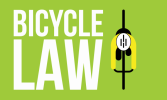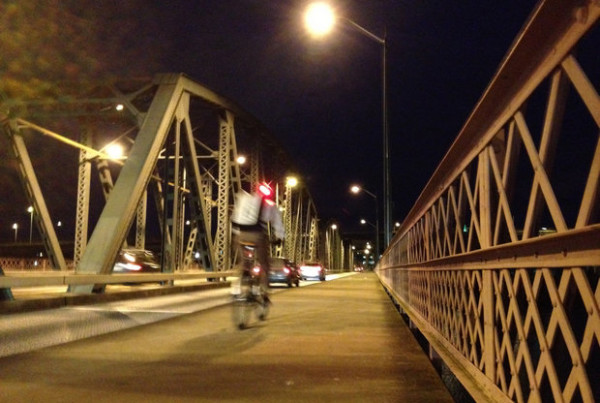The New York Times: Los Angeles Lives by Car, but Learns to Embrace Bikes
The fourth CicLAvia event, which closed 10 miles of Los Angeles streets to car traffic, drew nearly 100,000 bicyclists.
By ADAM NAGOURNEY
Published: May 19, 2012
LOS ANGELES — It was a warm April morning in downtown Los Angeles, and there was not a car on the road. For five hours, the streets were commandeered by nearly 100,000 people on bicycles — old and young, wearing spandex and silly hats, dogs and babies perched on handlebar baskets — in a celebration that produced a sight that once would have seemed inconceivable in this city of cars.
Taking a break during the CicLAvia event in Los Angeles in April. The city has added nearly 40 miles of bike paths in 18 months.
It was the fourth time this city closed its streets for the event known as CicLAvia, and it was the largest one yet.
These days in Los Angeles, there are midnight bike rides, East Side bike rides, women’s bike rides and nude bike rides rolling out nearly every day. In the past 18 months, close to 40 miles of bike paths and lanes have been created across the city and the City Council passed a measure to prevent bicyclists from being harassed by motorists.
On one recent evening, drivers came to a (mostly) uncomplaining stop as swarm after swarm of cyclists breezed through an intersection on Wilshire Boulevard, complete with a police escort. And on Tuesday, there was a “Blessing of the Bicyclists” — with a rabbi, a water-sprinkling priest and bikers in attendance — at Good Samaritan Hospital, which has treated its share of injured bikers over the years.
Bicycling is no longer the purview of downtown messengers or kamikaze daredevils. Its advocates include hipsters who frequent the bicycle repair cooperative known as the Bicycle Kitchen (which, experiencing growing pains, is about to move to bigger quarters) and middle-class riders who hum along a bike path on the beach in Venice and Santa Monica. There are biker-commuters who like to shock people by boasting that they do not own a car. And the mayor, Antonio R. Villaraigosa, who broke his elbow in a bike accident involving a taxicab and has since become one of cycling’s biggest cheerleaders, is intent on resurrecting a plan that he acknowledged had been “kind of languishing a bit.”
For years, bicyclists in Los Angeles were just another renegade subculture in a city that is teeming with all manner of subcultures. These days, they have become downright mainstream.
“I can’t keep up with all the group rides out there these days,” said Damien Newton, the founding editor of Los Angeles Streetsblog, which champions bikers and pedestrians. “This isn’t a side thing anymore. It’s definitely out of the shadows and out of the subculture.”
None of which is to say that this of all cities is about to give up the car for the bicycle. But at a time when Los Angeles is struggling to ease congestion — and when cities from New York to Portland, Ore., are outpacing this city in making life easier for the urban bicycler — the bicycle is becoming part of the transportation fabric in Los Angeles.
“There was not a biking network when I was there,” said Janette Sadik-Khan, who attended Occidental College here in the late 1970s and today is New York City’s transportation commissioner, leading the way in expanding a network of bicycle lanes. “You are beginning to see the bones of one emerging now, and it’s very exciting.”
Bicyclists have long complained that the Police Department blamed them in any conflict involving a car and gave cyclists tickets for even the most minor infractions. So consider this message posted by the group Midnight Ridazz after its most recent ride: “The Midnight Ridazz would like to extend a sincere thanks to the L.A.P.D. and especially to the officer (whose name we did not get) who recently helped to escort our ride through the streets of Los Angeles.”
Mr. Villaraigosa said he wanted the city to establish 40 miles of bike lanes and paths a year, a policy inspired by his own “nasty spill” dodging a taxicab and a part of his effort to cut back on automobile use here. “No question about it: bike ridership is up dramatically in L.A.,” he said. “You see it all over the city.”
For anyone who lives outside Los Angeles — and even for many people who live in Los Angeles — the notion of taking a bicycle to the roads here would seem someplace between daring and suicidal. And with some reason: two years ago, a doctor was sentenced to five years after being convicted of assaulting two bicyclists by slamming on his brakes during a confrontation in the Brentwood neighborhood.
The resentment goes both ways, as Hector Tobar of The Los Angeles Times said in a column last summer that was generally supportive of bicyclists. “People can be as reckless on a bike as they are behind the wheel of the car,” he wrote. “But stupidity with no steel around you to protect you is a more naked, brazen kind of stupidity — and that’s what drives a lot of Angelenos batty.”
Still, there appears to be a renegotiation of space taking place between drivers and bicyclists as they try to figure out how to share the pavement. And bike riders here say that the notion of Los Angeles being particularly hostile to cyclists is exaggerated.
“That is a big misconception,” said Iggy Cortes, 41, a manager of Orange 20 Bikes, a bicycle store across from the Bicycle Kitchen in central Wilshire, an intersection of Los Angeles filled with bikes and people carrying helmets. “You hear that from people who have never cycled in L.A.”
Mr. Newton said: “People always like to point out, ‘Oh, I see bicycles running stopping signs.’ I think proportionately there’s an equal number of jerks who drive cars as there are who ride bicycles.
“Ninety percent of the interactions I have with bikes when I’m in a car and 99 percent of the interactions I have with cars when I’m on my bike are positive. But it’s the 1 percent you remember.”
This would seem to be an ideal city for bicycling, with little rain, no snow, year-round sun, a population dedicated to fitness and abundant space. It is a way to escape clogged streets, and with gas on some corners nearing $5 a gallon, it is certainly cheaper.
“The popularity of cycling is totally surging,” said Jennifer Klausner, the executive director of the Los Angeles County Bicycle Coalition. “What I see is more and more people than ever before on bicycles, at all hours of the day and night. It’s taken a while for the city to catch up.”
Joel Epstein, a mass transit advocate, said traffic here had led him to use his bicycle more often. “L.A. is a very complicated kind of place,” Mr. Epstein said. “A lot of people are going to commute by car forever. But I think bikes are a piece of the puzzle, just like mass transit is and just like walking is.”
Under the bike plan approved by the city in March 2011, Los Angeles pledged to build approximately 1,350 miles of pathways, dedicated lanes and streets that were deemed bicycle friendly over the course of the next 30 years. There were already 350 miles in place at the time the plan was approved.
Nathan Baird, the bicycle coordinator for the city’s Department of Transportation, said the city installed 19 new miles of bikeways last year and 35 miles this year, and intended to build 40 miles of bikeways a year over the next five years. It will not be easy: competition for road space is particularly intense here.
“If you look at a street in Los Angeles, it has tiny little sidewalks and a huge amount of lanes for cars,” said Joe Linton, an organizer for CicLAvia. “Nothing at all that signals that bikes are welcome.”

